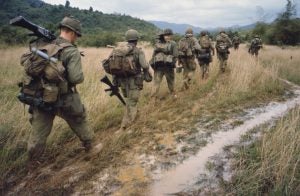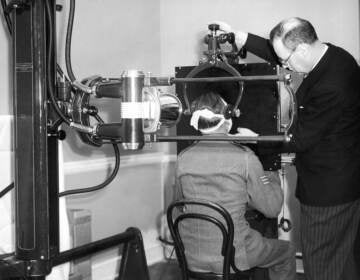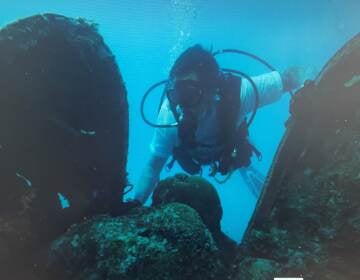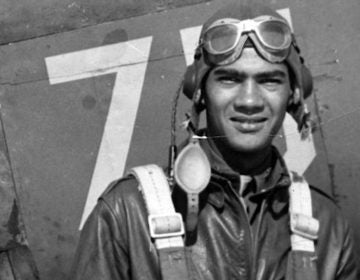The Huey and the Vietnam veteran
The sound of the iconic Huey helicopter is unmistakable to a Vietnam veteran.
The sound of the iconic Huey helicopter is unmistakable to a Vietnam veteran.
The rhythmic thumping of the rotors is hypnotic and often takes vets back in time to when they served during the Vietnam War.”In Vietnam, almost every veteran has a story to tell about a Huey,” said Jim Haga, president of Liberty War Birds, a nonprofit based in the Lititz, PA.
The Vietnam veteran believes reuniting his fellow vets with the Huey could be cathartic. Just getting back into a helicopter, albeit not a Huey at the time, and flying again helped Haga who struggled with late onset PTSD. That’s why he founded Liberty War Birds.
“I realized there was an opportunity there to help other vets connect with the aircraft. It might be healing for some of them, but it’s always a choice. I just wanted to give them the opportunity. That’s what Liberty War Birds is all about, trying to get this aircraft in front of veterans, in a sense to give them the opportunity to reconnect and to just honor them.”
Two years ago, the nonprofit scraped together $250,000 in donations to buy a Huey. The aircraft’s serial number was 66-16823. The first two numbers indicate when the helicopter was built, 1966.
Since Liberty War Birds acquired Huey 823, as she’s called, about a dozen dedicated volunteers come to a hangar at the Lancaster Airport every weekend to rebuild her. The majority of those volunteers are Vietnam War vets.
“It’s like a kid with a big train set,” said volunteer Steve Rosinski, who served as a crew chief in a Huey in Vietnam. “So when you can get to work on one of these things it’s neat. It’s just fun.”
But Haga said he and his volunteers are doing more than just fixing up 823’s paint.
“Right now what we’re doing is restoring a Vietnam veteran UH-1H helicopter to flight status. It’s not going to be a static display, we’re going to get it flying again,” Haga said.
PTSD therapist and Vietnam veteran Alexis Lake volunteers her time with Liberty War Birds and also serves as the vice president of maintenance. Lake said she has witnessed the powerful emotions and connection vets feel when they touch or sit in the 823.
“Remember that when Vietnam vets came home, we were told, don’t tell your stories. Everybody said, ‘Get out of your uniforms, get into civilians,’ because the population in America at the time took out their angst about the Vietnam War on the troops,” Lake said. “The stories may be buried, but the emotions are always filtering up.”
Lake hopes reuniting with the iconic Huey will help vets remember those stories, good and bad, and eventually lead to some level of healing for them.
The Bikini Blue
The 1966 Huey served in Vietnam from 1968 through 1970. She was among 7,000 UH-1 helicopters deployed during the war. The single-engine helicopter was a workhouse, widely used for medical evacuation missions (medevac) and moving troops quickly from one landing zone to another.
Huey 823 accumulated over 1,300 combat hours in Vietnam and has the bullet hole patches to prove it. She was part of the 170th Assault Helicopter Company out of Fort Benning in Georgia. The company adopted the nickname “Bikinis.” The two flight platoons were nicknamed, “Bikini Blue,” and “Bikini Red,” and a custom painted picture of “Annie Fannie,” of Playboy fame, was featured next to a winged dragon on each aircraft’s nose.
Huey pilot Russ Mowry found out about the Liberty War Birds’ restoration of Huey 823 on the 170th AHC Facebook page and drove down to Carlisle, Pennsylvania to meet Haga and the aircraft at the United States Army Heritage and Education Center’s annual Army Heritage Days event last May. There, he recreated the nose art he first painted almost 50 years ago. Haga said Mowry later discovered he had flown 823 in Vietnam.
Bittersweet moment
Vietnam was where Army aviation took off. The Huey revolutionized Army combat operations. However, the UH-1 has since been replaced with the UH-60, or Blackhawk helicopter, because the military wanted something bigger, faster and more powerful.
Active duty and National Guard units started transitioning to the Blackhawk in the ’80s.
“The Huey was a great aircraft, but when we got into the Cold War era and stuff like, they realized they needed an aircraft that could do more. Like they needed to carry more troops, be able to move more equipment, so they wanted a bigger aircraft. The Huey was single engine, the Blackhawk is dual engines,” explained Lt. Col. Darin Schuster with the Delaware Army National Guard.
Schuster said the Delaware Army National Guard was one of the last three medevac units to still operate Hueys through 2009. Towards the end, Schuster said the Guard had only six left. The 1969 Huey, serial number 69-15171, was revered in the unit and Schuster’s favorite.
“It was built new, sent over to Vietnam, wasn’t even there for a year and was shot down, received battle damage, was recovered, sent back to Texas, rebuilt and then stayed stateside for the rest of its life,” Schuster said. “It was just the fact that you knew that that aircraft flew in Vietnam with pilots that were pioneers of Army aviation and just that history and that connection — I think that just meant a lot to a lot of people.”
Schuster flew 171 from New Castle, Del. to Fort Polk in Louisiana where he would turn her in for good. Schuster recorded the farewell trip in a personal flight log and remembers each leg of the flight in great detail, including with whom he flew, how many hours he was in the air and where he refueled and spent the night.
“You don’t really ever think about the day that you’re going to have to walk away from that aircraft, and when that day finally came, it’s a bittersweet moment,” Schuster described.” I remember when I shut it down for the last time, it was like you’re not going to do that again. And it was kind of a sad day.”
At 45-years-old, Schuster was just a baby as U.S. troops withdrew from Vietnam. But he still managed to forge an unspoken friendship with 171, like many who came before him with other Hueys.
Joe Startt, Jr. fought in Cu Chi Vietnam with the 25th Infantry Division for nine months and 27 days.
“All of a sudden I heard this bloop! Well I knew what that was, it was an M79 going off,” said Startt, who was hit by friendly fire, although he didn’t know it at the time. “The shrapnel caught me. Caught me in my neck, collapsed my lung, broke two ribs, blew my thumb off.”
When the gunfire finally stopped, and a dustoff crew arrived, a friend in Startt’s unit got him onto the helicopter that transported him to the hospital.
“I think being on the chopper, the air blowing through the doors and me being cold saved my life,” Startt said.
I asked Startt if he remembers hearing the rotors of the Huey thumping and before I could even finish asking, he said, “Oh my God, yeah, that was just like the angels dropping down out of the sky. When you hear that, it’s just a wonderful feeling, especially being on the ground, wounded and knowing help’s coming and these guys don’t care if you’re taking fire on or whatever they’re doing, they’re coming in. They give their life for us, you know.”
Startt said he would love to fly in a Huey again, this time sitting up.
Coming back to life
The folks with Liberty War Birds are hoping to start Huey 823’s engine this year. Best case scenario, they could get her back flying with veterans on board next spring.
Don Beatty flew Hueys in Vietnam and said he’s nervous about flying one again because of all of the good and bad memories connected to the bird.
“Just to feel her come back to life, and being able to do things with her that I haven’t done in a while and that aircraft hasn’t done in a while — it’s kind of a, almost a bittersweet thing,” Beatty said. “I’m really anticipating, looking forward to flying her, but realizing that it could be a very emotional moment for me and a lot of the other people that are involved with her.”
The Huey may be a machine, but for so many veterans it’s so much more than that: it’s a friend, a lifesaver, a brother-in-arms.
WHYY is your source for fact-based, in-depth journalism and information. As a nonprofit organization, we rely on financial support from readers like you. Please give today.






